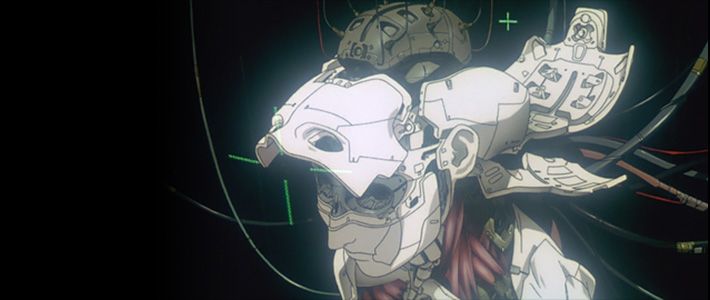
Manga and Anime in Japan Today
Deciphering the Universality of Oshii Mamoru’s “Ghost in the Shell”
Culture- English
- 日本語
- 简体字
- 繁體字
- Français
- Español
- العربية
- Русский
The US live-action science-fiction film Ghost in the Shell, released in March 2017 in its home market and a month later in Japan, is based directly on the landmark Japanese manga Kōkaku kidōtai, first serialized in 1989 by the edgy and innovative artist Shirow Masamune. However, many of the visuals and settings of this new Hollywood version are homages not only to Shirow’s original work, but also to the 1995 animation version of Ghost in the Shell/Kōkaku kidōtai by the famed Japanese anime director Oshii Mamoru.
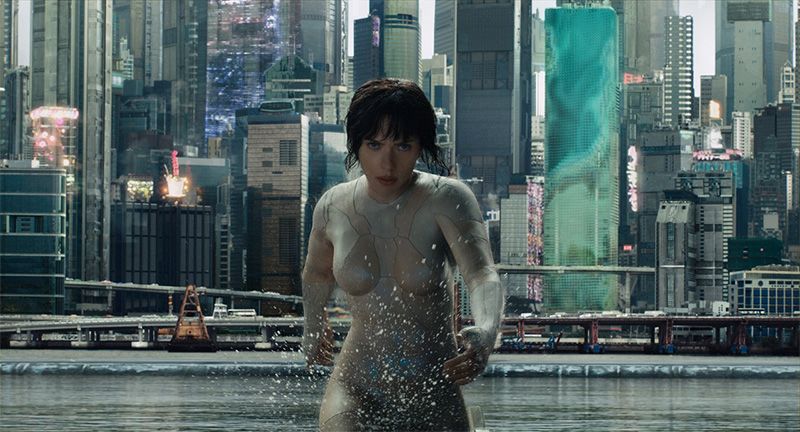 Ghost in the Shell, released in spring 2017, is directed by Rupert Sanders and features Scarlett Johansson in the role of a public security investigator whose entire body except for her brain has been converted into a cyborg. (© MMXVI Paramount Pictures and Storyteller Distribution. All rights reserved. Japan distributor: Tōwa Pictures.)
Ghost in the Shell, released in spring 2017, is directed by Rupert Sanders and features Scarlett Johansson in the role of a public security investigator whose entire body except for her brain has been converted into a cyborg. (© MMXVI Paramount Pictures and Storyteller Distribution. All rights reserved. Japan distributor: Tōwa Pictures.)
The video release of Oshii’s Ghost in the Shell won an avid following overseas, at one point soaring to first place on Billboard Magazine’s weekly video rankings for the US market in 1996. It powerfully influenced the 1999 global hit The Matrix and has left an indelible mark of countless subsequent animated films and special-effects extravaganzas, both in Japan and abroad. Of course, part of the popularity of the film was the allure of the hardcore heroine Kusanagi Motoko herself, but fans were also enthralled by the visual surprises of its futuristic technologies—like thermoptic camouflage allowing characters to disappear into the background—and dynamic action scenes like Kusanagi’s deadly shootout with a multilegged robot tank. There have been many more films and television episodes set in Shirow’s Ghost in the Shell universe since, including Oshii’s own 2004 sequel Inosensu (Innocence). But Oshii’s 1995 original remains in a class of its own.
Less well known, however, is that both the manga and the movie’s freshness and unique worldview owed much to the historical backdrop of Japan from the early postwar years up to the mid-1990s.
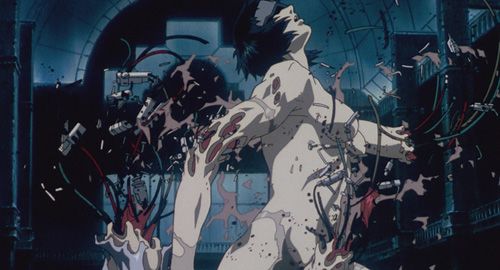 Kusanagi Motoko, heroine of Oshii Mamoru’s 1995 Ghost in the Shell. (© Shirow Masamune/Kōdansha, Bandai Visual, Manga Entertainment)
Kusanagi Motoko, heroine of Oshii Mamoru’s 1995 Ghost in the Shell. (© Shirow Masamune/Kōdansha, Bandai Visual, Manga Entertainment)
The Cyborg as Self-Portrait
Ghost in the Shell is science fiction on the theme of cyborgs. In a future society that has come to accept the use of mechanical gitai (cyborg bodies), security police investigators pursue a challenging case while continuously sharing information in real time through a dennō (a term based on diannao, the Chinese characters for “computer”) network. “Cyborg” is originally a contraction of the English phrase “cybernetic organism,” indicating a modified biological organism in which a portion of the organs and other body parts have been replaced with artificial components, allowing it to operate in extreme environments like the frozen emptiness of space or crushing ocean depths. This medical term originated in the early 1960s against the backdrop of the early exploration and exploitation of space during the Cold War.
The work that made “cyborg” a household word in Japan was the manga artist Ishinomori Shōtarō’s Saibōgu 009 (Cyborg 009), first serialized in 1964. The story’s conceit was that in a world where war rages without end in every part of the globe, the merchants of death supplying weapons to all the different sides in the fighting organize and begin forcibly converting kidnapped civilians into cyborg soldiers. The affinity of cyborgs for warfare was powerfully depicted.
However, nine of the cyborgs flee the death merchants’ organization and become heroes as they turn on their creators and fight for the good of mankind. Pay particular attention to how these characters, originally rebuilt to be “human weapons,” take their special powers originally intended for battle and use them instead in the cause of peace. We can see behind this conceit both Ishinomori’s self-reflection on how, over the course of the 50 years since its defeat in World War II, Japan had leveraged the economic demand generated by the Korean War to its advantage and achieved rapid economic growth, and the trend toward the peaceful application of military technology.
As Japan entered the 1970s, the problem of pollution deepened, and concern grew again about the negative fallout of science and technology run amok. Once more, the popularity of “cyborg heroes” soared. The representative example, again based on an original work by Ishinomori, was the 1971 tokusatsu special effects television drama Kamen raidā (Masked Rider). This program launched the so-called henshin būmu (transformation boom) that continues in Japanese tokusatsu and anime culture to this day, in which human—and sometimes alien—heroes and heroines transform into super-powered warriors. Yet these stories can also be read as a nightmarish vision of Kamen raidā in which normal people are turned into cyborg monsters by the evil organization Shocker that battles the masked hero. In shows like Kamen raidā lurked a latent fear of the threat the warped application of science and technology could pose to the human race, and a desire to surmount this challenge.
In this way, the Japanese conception of cyborgs was, in a sense, a self-portrait of postwar Japan itself. It was this that made these works so easy for mass audiences to embrace, triggering the “transformation” boom.
Questioning Humanness in a “Cyberized” Society
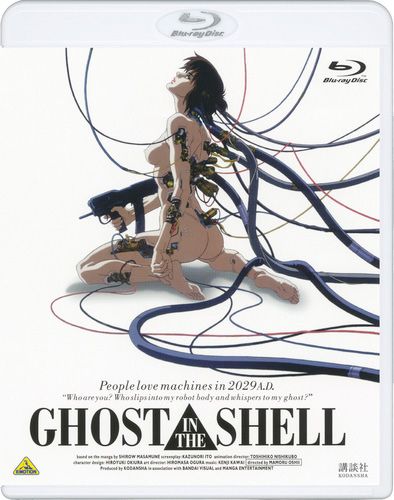 Ghost in the Shell Blu-ray edition, Bandai Visual. (© Shirow Masamune/Kōdansha, Bandai Visual, Manga Entertainment)
Ghost in the Shell Blu-ray edition, Bandai Visual. (© Shirow Masamune/Kōdansha, Bandai Visual, Manga Entertainment)
The 1980s also brought another transformation that would prove intimately tied to Ghost in the Shell. Rapid advances in electronics gave rise to devices like the Sony Walkman, video games, and personal computers, as entertainment trends shifted increasingly from the masses to a focus on the individual. Around the world as well, by the late 1980s the Cold War was winding to a close, replaced by the rise of localized conflicts and terrorism, while war itself was becoming ever more “electronic” in nature, with the human factor increasingly excluded from decision-making and command-and-control.
This was also the era when the otaku phenomenon first caught the attention of Japanese society at large, marking the onset of an era when the likes, dislikes, and consumer behavior of individuals trumped the collective tastes of mass society. Further accelerating this shift was the rise of networked communication. Unprecedented modalities for sharing and exchanging opinion sprang up, and society as a whole had no choice but to pay attention. One reflection of this transformation was the appearance of a new genre of science fiction that shared the same etymology as cyborg: “cyberpunk.” Set in future societies in which the consciousness of individuals and groups were incorporated into higher-order networks, expanded, and “cyberized,” cyberpunk depicted a world of sometimes excessive interaction between man and machine. It predicted an entirely new modality of evolution, fusing the human and the inhuman.
No wonder, then, that when Shirow’s original Ghost in the Shell was first published in 1991, it was received as cutting-edge cyberpunk. Shirow’s meticulously detailed futuristic settings, art, and storytelling made the daily lives of his cyberized characters seem totally natural, while the vision he suggested would emerge from this new “cyber world” came as both thrill and shock to his readers.
Yet what I would particularly like to focus on here is that Shirow’s real obsession—in complete opposition to the approach of virtually all other “robot” SF up to this time, be it in manga, fiction, or film—was the essence of what it means to be “human.” Tezuka Osamu’s Tetsuwan atomu (Astro Boy), first broadcast on television in 1963, pondered the “human rights” of robots, and can be seen as a subbranch of the genre of “artificial humans” reaching back to Mary Shelley’s 1818 Frankenstein. Beginning from the inanimate, these works sought, through the power of science, to create a new kind of existence close to “human.”
In contrast, a cyborg starts out as human and becomes the other. The question is not how human cyborgs can become, but rather, how much of our biological selves can be stripped away and replaced with machines before we ourselves lose our humanity. Are we still human if our vital organs are replaced with machines and electronics? What, ultimately, is it that defines us as still being human?
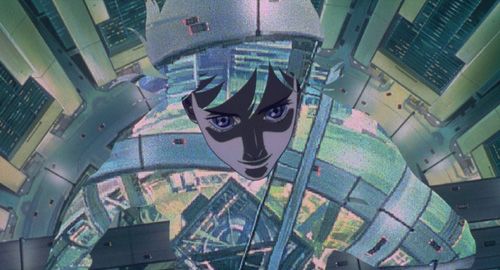 Ghost In the Shell depicts a computerized society in which most people’s brains have been cyberized to allow them to connect directly into vast networks of data. (© Shirow Masamune/Kōdansha, Bandai Visual, Manga Entertainment)
Ghost In the Shell depicts a computerized society in which most people’s brains have been cyberized to allow them to connect directly into vast networks of data. (© Shirow Masamune/Kōdansha, Bandai Visual, Manga Entertainment)
The term “ghost” that appears time and again in Oshii’s Ghost in the Shell emerges from this fundamental question of what defines our humanity. Within the movie itself, the definition of “ghost” is left deliberately vague, but it is used primarily to indicate an individual’s ego and consciousness and, perhaps, even its spirituality. Oshii’s Ghost in the Shell constructs its entire story around just one episode from Shirow’s original work, in which the “Puppeteer,” a self-described new “life form born of the digital ocean,” seeks to obtain a “ghost” of its own and accelerate the course of evolution.
Recent years have brought fresh attention to new concepts like deep learning, the singularity, and virtual reality. Today we should be able to take the perplexing question of what constitutes the “true nature of being human” that is Ghost in the Shell’s central preoccupation as a much more pressing, and personal, issue than audiences did when it was first released.
Driving the Evolution of Video Expression
It is also of particular interest that Oshii’s Ghost in the Shell was released in 1995. This was the time when it first became possible to remain constantly connected to networks. The much-ballyhooed release of Windows 95 accelerated the spread of personal computers. The new word “Internet” was on everybody’s lips; later, advances in mobile phones put them in constant contact with the net, and broadband became a reality. Even if our physical bodies had not been “cyberized,” a small handheld device had already made it possible to send messages anywhere, anytime—enabling a voiceless mutual understanding not so far departed from telepathy—and triggering a monumental transformation in both the volume and very nature of communication. The cyber age was becoming a reality before our eyes.
The enduring freshness of Oshii’s video expression is another of the allures of the film. In his animation version, Oshii poured special effort into presenting an entire worldview through landscapes. In one of his earlier works, the 1989 anime film Kidō keisatsu patorēbā gekijōban (Patlabor: The Movie), Oshii hunted out actual locations around Tokyo, using the black and white photographs he shot as hints to infuse the movie with the visceral truth of real places. For Ghost in the Shell, he and his staff went location hunting in Hong Kong’s chaotic Kowloon district just before the then British colony’s reversion to China, creating a near-future landscape for the movie based on a semisubmerged Chinese city. The visuals of the resulting backgrounds, chaotically jumbling together both the new and the old, stagnation and vitality, supplement the abstraction of the Zen kōan riddle at the heart of the film as it questions what it means to be human, or not.
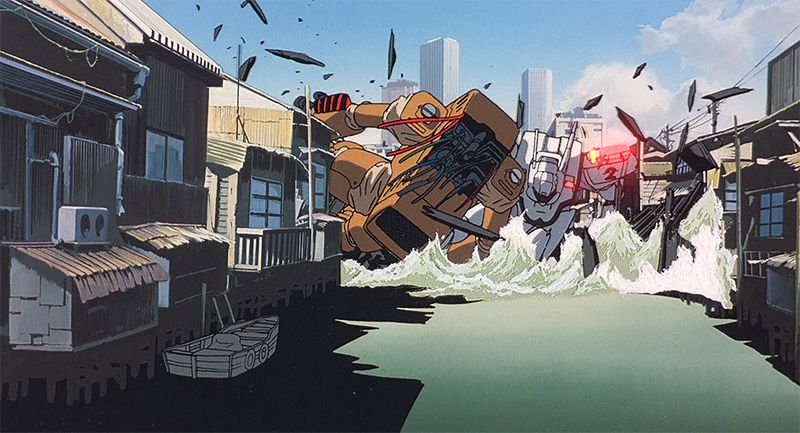 In Patlabor: The Movie (1989), the Labors (human-piloted robots) of the Tokyo Metropolitan Police’s Special Vehicles Division 2 try to restore order in a fin-de-siècle Tokyo. (© Headgear/Bandai Visual/Tōhokushinsha)
In Patlabor: The Movie (1989), the Labors (human-piloted robots) of the Tokyo Metropolitan Police’s Special Vehicles Division 2 try to restore order in a fin-de-siècle Tokyo. (© Headgear/Bandai Visual/Tōhokushinsha)
One last thing we should not forget as we look back on Ghost in the Shell is the “cyborgization” of anime itself. Oshii’s Ghost was a product of the closing days of analog anime production. When it was produced, the norm was still to creating an animated movie by photographing and filming hand-drawn and hand-painted cells and background art. By mixing in digital photographic processing and 3D computer graphics, Oshii also pushed the evolution of video expression itself. Thanks to this harmonization of the film’s visionary content and its new modes of video expression, the viewer unconsciously forgot the real world and was lured into a future rocketing toward a coming cyber reality. In effect, the audience’s own brains were hacked by Oshii’s movie-making techniques.
Oshii’s Ghost in the Shell projected the daily reality and image of the future held by the Japan of 1995, at the same time providing a comprehensive take on the true meaning of being human—a question that had been posed time and again since Japan’s earliest cyborg tales of the 1960s. By brilliantly encapsulating that universal question and conveying without words a message about the evolution of a life form that could be one future of the human race itself, it won the admiration of the world. This was truly the birth of the “myth of the net age,” and Ghost in the Shell has secured a unique place in the history of world cinema.
(Originally published in Japanese on May 15, 2017. Banner image: Cyborg Kusanagi Motoko is assembled in the title sequence to the 1995 Ghost in the Shell. © Shirow Masamune/Kōdansha, Bandai Visual, Manga Entertainment.)